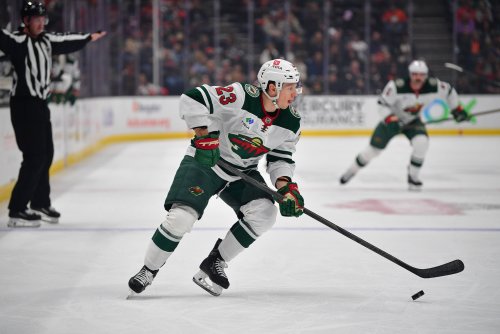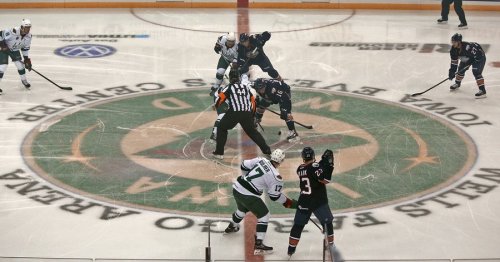
If Biggie was right, Brock Faber is about to have a whole lot mo' problems.
If the Minnesota Wild can’t pull off a miracle run to the playoffs, Faber’s Calder Trophy watch might become the main event for fans as the season winds down. That end-of-year performance could also have a significant impact on his career earnings.
In the Athletic’s latest Minnesota Wild mailbag, Michael Russo and Joe Smith reported that the defenseman from Maple Grove could sign his first contract this summer:
It seems certain the Wild will look [this summer] to sign him to a max eight-year deal, and he’s almost certainly looking at an average annual value above $8 million per. Jake Sanderson signed an eight-year, $64.4 million deal with Ottawa. They’re both 21. That’s the comparable.
It looks like “above” is doing a lot of heavy lifting in that sentence.
It makes sense that Sanderson is the best comparable. He’s another high-end defenseman from the 2020 draft, and Sanderson also signed his extension with one year remaining on his ELC. That makes the Sanderson contract an excellent starting point to estimate Faber’s extension.
However, several differences between the players suggest Faber is more valuable than Sanderson. That puts Faber in line for an even bigger payday.
First, the basics: Faber shoots right, while Sanderson shoots left. That wouldn't matter as much if they were forwards, but the NHL has a shortage of right-shot defensemen. NHL coaches prefer to put a right-shot defenseman next to a lefty because it makes puck retrievals, breakout plays, and holding the offensive zone much easier. Looking at the contracts for some of the top defensemen in the league, there’s a difference of about $1 million AAV or more between righties and lefties.

Faber also has an edge in production. In 2022-23, Sanderson’s rookie year, he scored four goals and 28 assists in 77 games. Faber has already scored four goals and 25 assists this year, on pace for six goals and 39 assists in 77 games. On top of that, Sanderson posted a minus-6 +/- last year, while Faber currently has a plus-4.
Goals, points, and +/- can describe past performance well but don’t project future performance effectively. Advanced statistics are much better predictors of future success. The Athletic’s player cards are a great tool to easily understand multiple facets of a player’s abilities using some of the most robust analytics available. Faber’s and Sanderson’s are pictured below:


The highlights are the two numbers at the top right (net rating) and at the bottom left (market value). These are the catch-all numbers that estimate each player’s total value. The model above estimates that Faber is worth $8.2 million against the 2023-24 salary cap -- $1.9 million more than Sanderson, or 30% of Sanderson’s value. Against Sanderson’s $8.05 million cap-hit, that 30% projects to a $10.48 million value.
The great thing about “net rating” is that it’s easily broken down into offensive and defensive components. Faber leads Sanderson in defense, and Sanderson is in the midst of a better offensive season. However, these cards indicate that Sanderson is running hot while Faber is due for some positive regression. For that reason, the model predicts both players will finish the season with similar offensive impacts.
The offense and defense components are especially interesting. First, the NHL players with the best net rating (read, the best players in the world) typically do so with middling defensive numbers and exceptional offensive numbers. See below based on this year’s player cards:

That makes sense. Offense requires players to beat the other team’s defense and the goaltender. Furthermore, you can always score more goals, whereas defense can only limit the other team’s offensive production to zero. Finally, the best players possess the puck more often, leading to better offensive statistics.
Sanderson fits the offensive mold of the NHL’s best defensemen, which could be a mark against Faber. Both players will need to develop their offense to become top-15 defensemen, but right now Sanderson looks the part of an offensive defenseman in a way Faber does not. Faber’s power play numbers are better, though, which may indicate he’s got the quick hands and vision to become a modern No. 1 defenseman.
Faber’s defensive superiority is also an important consideration because of how that skill “ages.” Faber’s contract will extend one year later into his lifetime. Ottawa paid for Sanderson at ages 22 through 29, while Faber’s contract would cover ages 23 through 30. That means Faber’s contract must project for his age and accommodate the decline in ability that comes with it. Aging curves best estimate a player’s on-ice analytical impacts over time, and the people at hockeyviz.com have researched aging curves extensively.
Note how the age curves differ for the offensive, defensive, and special teams portions of a defenseman’s game (blue lines):
Offense:

Defense:

Power Play:

Shorthanded:

Faber’s defense and his work on the power play are his foundation. HockeyViz’s research indicates that his defense and power play production should age gracefully. At age 30, most defensemen are better on defense than they were at age 21, and they generally continue to improve on the power play until retirement. So there’s little cause for concern to sign Faber through age 30.
Another contract consideration is the calendar years covered by the deal. The Senators will pay out Sanderson’s contract during tighter cap environments because it starts one year sooner. Assuming the cap increases by about 3% annually, Faber’s contract should be about 3% more expensive. On an $8 million AAV, that’s about an extra $250k per year.
Faber is better in nearly every area of the game aside from the penalty kill and five-on-five offense. Even then, it's hardly fair to evaluate his performance on the penalty kill, given Minnesota’s larger systematic problems on that side of the puck. While the Senators score more at 5-on-5 with Sanderson on the ice (3.24 goals per hour) than the Wild score with Faber on the ice (2.74), Faber is still doing better as a rookie than Sanderson did last season (2.35). Furthermore, Faber's 5-on-5 production (17 points) surpasses even Sanderson (13 points) this year. That all makes Sanderson an intriguing starting point on which Guerin can negotiate with Faber’s agent.
Faber's eventual number might go well past Sanderson's starting point, too. Overall, Faber’s camp has a great argument that his value is well above Sanderson’s. By the analytics (30% better than Sanderson), the cap environment (3% annual growth), and factoring in Faber’s value as a righty ($1-2 million AAV), his agent could make an argument for an AAV around $11-12 million. Realistically, the Wild would probably break even if they met in the middle on a $10 million AAV. But it would be unprecedented to offer that to a 21-year-old rookie defenseman.
Ultimately, Guerin holds a lot of negotiating leverage and will want to keep Faber’s number as close to Sanderson’s as possible. Any extension will require both sides to strike a deal, and the Wild don’t need to rush the process. Faber is under contract for the 2024-25 season, and he’ll be a restricted free agent after that. Finally, the security of a long-term contract is worth a great deal to young players.
The main reason to believe the two sides will strike a deal is Guerin’s history of establishing cost certainty. That has been especially true when Guerin locks up the team’s young stars. He extended Matt Boldy, Joel Eriksson Ek, and Kirill Kaprizov on long-term deals at a time when most other teams took advantage of bridge deals that were cheaper, but shorter. Neither Boldy nor Kaprizov had played 82 NHL games before signing extensions, and all three of those deals extended for five to eight years. These contracts were big bets based on sound analytics. They’re also effectively front-loaded after factoring in a rising salary cap.
So far, all of those gambles are paying off.
It'd be shocking if Faber doesn’t make substantially more than Sanderson, but given the team’s leverage, it doesn't feel like this extension will go much higher than $9.5 million. Either way, Brock Faber is about to get paid.
Think you could write a story like this? Hockey Wilderness wants you to develop your voice, find an audience, and we'll pay you to do it. Just fill out this form.
-
 2
2
-
 1
1








Recommended Comments
Join the conversation
You can post now and register later. If you have an account, sign in now to post with your account.
Note: Your post will require moderator approval before it will be visible.